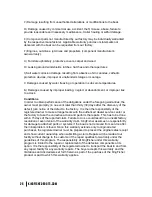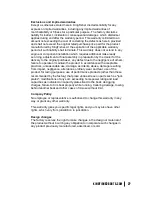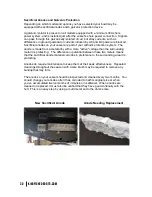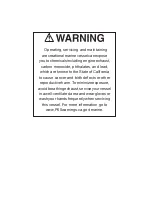
www.kingfisherboats.com
27
KINGFISHERBOATS.COM
29
Identifying and Managing Corrosion
After every voyage you must pay special attention to the overall cleanliness of your
vessel. No different than storing your gear and hanging items to dry, there is a need
to clean off the saltwater that has come into contact with your vessel during your
outing. A thorough freshwater wash down is an effective way to reduce the risk of
corrosion, which could require extra maintenance in the future. Places like under your
cutting board, aft helm, and nylon downrigger mounts are examples of points of
contact that aren’t meant to be watertight and should always be well rinsed with fresh
clean water after every use. For best results, an initial quick heavy mist well help
loosen the dried salt crystals. Follow this up with a heavy rinse working from the top
down, putting extra spray into areas with tight contact points that have little chance of
drying up quickly on their own.
Bilge compartments must also be kept as clean as possible by flushing with fresh
water every time you return to dock. Make sure all internal drain-ways are free from
scum build-up and loose debris. If you notice a white powder forming in crevasses it’s
a sign this area has been overlooked in previous cleaning attempts. Clean this
powder with a stainless tooth brush so the aluminum can once again form a new
oxide layer. This type of corrosion will require immediate attention to stop further
growth and should not be delayed.
Chipped paint from stones while trailering, or a scratch from a loose deck board, will
also have a negative effect when in contact with saltwater. Exposed aluminum in your
paint finish will allow moisture in between the paint and hull. This will cause paint to
blister and peel. It is important to seal any exposed areas to prevent corrosion forming
and spreading.
Blistering and peeling paint around fasteners and fittings or chalky white powder is a
sign that galvanic corrosion may be taking place. These are areas not properly rinsed
from previous trips or areas where movement of a loosened fastener has allowed
water to enter and make contact between the stainless fastener and bare aluminum.
This component must be removed and the corrosion must be eliminated by light
sanding at a minimum. The affected area will then need to be recoated with matching
paint. The component should then be reinstalled using the “
New Component
Installation Instruction
” guide.
Содержание COASTAL Series
Страница 1: ...C0ASTALn MULTI SPECIES n SPORTn RIVER JET OWNER S MANUAL ...
Страница 2: ...OWNER S MANUAL ...




















